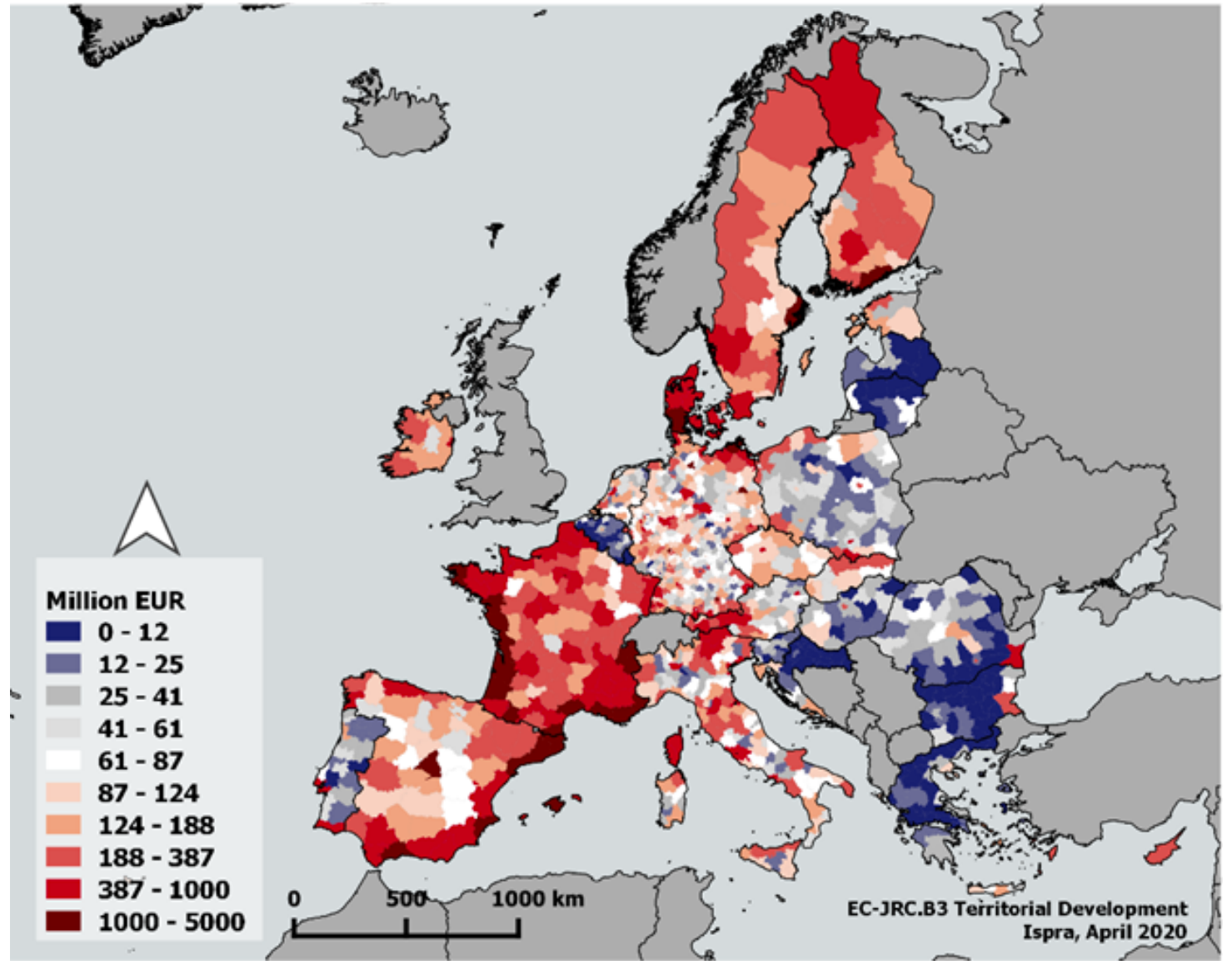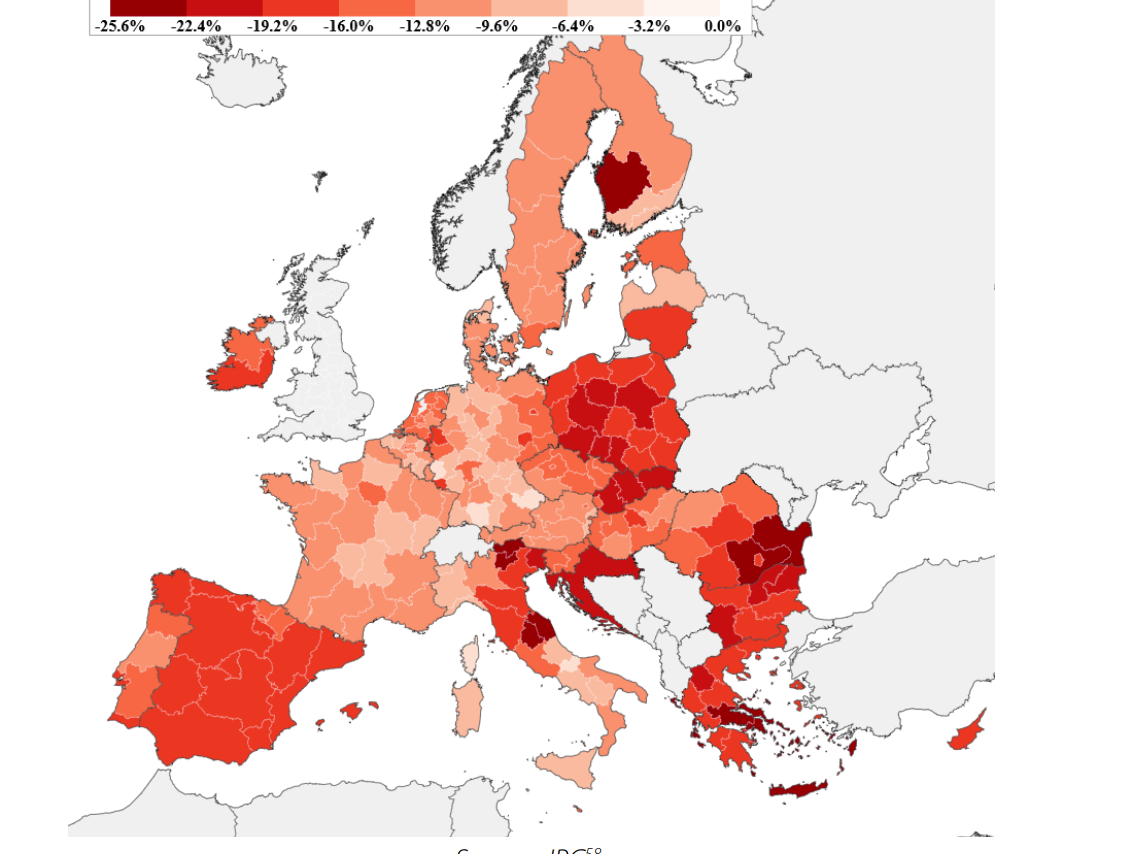Impact of the Crisis Caused by the Covid-19 Pandemic on EU Cohesion


The COVID-19 pandemic is affecting severely the EU territory. As a consequence, the economic, social and territorial cohesion of the Union is disrupted.
The COVID-19 pandemic affected countries and regions at different times and in a completely different level. Across the EU Member States, significant numbers of cases were usually concentrated within a restricted number of regions. Even in countries with very high registered numbers of cases and deaths, such as Spain and Italy, several regions had relatively low numbers of cases. As a consequence the impact on EU regions was different.
Almost all the EU population has already experienced several periods of lockdown with strong containment measures. Although they are crucial for the strategic control of the pandemic, their downside are the ensuing important economic and social consequences.
In order to fight the pandemic, EU Member States introduced a variety of restrictive measures, which had important economic and social cost. The most socially and economically affected regions are those that were under strict lockdown for the longest period. The most struggling regions are also the ones relying on economic sectors such as tourism or the cultural industry. Another affected regions are the ones with an important share of SMEs, self-employed people, companies highly dependent on international trade. The regions with a significant share of high risk sectors such as manufacturing, accommodation and food services, wholesale and retail trade and motor vehicle repair sectors are also heavily affected as shown on .

The GDP of the European Union decreased dramatically because of the COVID-19 pandemic. According to the Eurostat data, the historical magnitude that this crisis is having on individual EU countries was enormous. This ranges from a decrease of 22.1% in GDP in Spain and 19% in France in the second quarter of 2020 compared with the same quarter in the previous year, to a decrease of 5.2% in Finland and 3.7% in Lithuania. According to a first estimation of annual growth for 2020, based on seasonally and calendar adjusted quarterly data, GDP fell by 6.8% in the euro area and 6.4% in the EU.1
Early research results also suggest that the economic impact of the COVID-19 has an important geographical dimension. The impact on GDP in the EU regions is differentiated, with variations within countries as shown on .

What is more, the effects are expected to last. In just a couple of member states GDP should return to 2019 levels by 2022. However, in some of the most affected member states, such as Italy, the recovery is expected to happen in 2025.
Unemployment across the EU may not fall to its pre-covid levels before 2024-2025. Some countries can even suffer the worst economic impacts next year. This is partly due to short-term support schemes introduced by governments. At the same time, they can entail delayed effect on employment because of delayed bankruptcy of businesses.
Despite that the real effects of the crisis in the long-term are still not clear, deeper economic inequalities between EU members are likely to emerge.
The expectations are that most of the North and all the countries of the Visegrad Four can recover quickly. However in EU’s South and South-east, the economic consequences of the crisis could affect their economies for longer periods. This will produce significant disruption in the EU cohesion. This can ruin the results of the long-term efforts of the EU. It is important to outline that in 2019 (immediately before the crisis) the EU cohesion was in one of its best levels: Belgium, Luxembourg, and the Netherlands – but also Hungary, Slovakia, the Czech Republic, and Estonia achieved good results. Central and eastern Europe has seen the highest increase in structural cohesion over the past decade, and the four Visegrad countries (the Czech Republic, Hungary, Poland, and Slovakia) and the three Baltic states (Estonia, Latvia, and Lithuania) were all well above the EU average.
The immediate response of the EU addresses both the health crisis and the economic recovery.
Among the important initiatives are namely:
The Coronavirus Response Investment Initiative (CRII). Introduced in March 2020, it gathered unused funding of EUR 8 billion, then introduced simple rules of its spending. Among the new provisions introduced are the possibility of a transfer between different priorities. It allows transfers of up to 8% of the allocation of a priority (less than 4% of the total programme budget) to another priority under the same ERDF, ESF or Cohesion Fund programme without approval from the European Commission. What is more, financial instruments under ESIF have the mandate to provide support in the form of working capital to SMEs. A key element concerns the removal of recovery orders for amounts that will be returned from the benefiting Member States in 2020. This will mobilise unused pre-financing for 2019 of about EUR 8 billion and provide immediate liquidity.
The Coronavirus Response Investment Initiative Plus (CRII+) adopted in April 2020, which introduced amendments such as a 100% cofinancing rate and easier rules for necessary funds realocations. It introduced new crisis-related exceptional measures for the use of ESIF. The most important amendments include:
increased co-financing rate of 100 % for the accounting year 2020-2021 for ERDF, ESF and Cohesion Fund programmes;
transfers between ERDF, ESF and Cohesion Fund for programming for 2020 without affecting resources allocated to European territorial cooperation, outermost regions, the Youth Employment Initiative (YEI) and the Fund for European Aid to the Most Deprived (FEAD);
transfers between categories of regions for programming for 2020;
exemption of allocations transferred between priorities under ERDF, ESF and Cohesion Fund programmes from thematic concentration;
extension of the possibility to provide working capital through financial instruments to the European Agricultural Fund for Rural Development (EAFRD) (see CRII);
possibility to exceed the allocated budget of a priority by up to 10 % if it is compensated through a corresponding reduction of another priority under the same programme;
simplified procedures and fewer requirements, e.g. for partnership agreements, financial instruments, reporting, ex-ante assessments, verification documents, and audits.
Furthermore, for rural policies, several exceptional measures were adopted such as emergency assistance, higher payment advances and lower administrative requirements.
Policy measures related to rural development at EU level run, first and foremost, under EU Common Agricultural Policy (CAP). CRII+ introduced several changes that are of particular relevance for Rural Development Programmes (RDP) funded by the European Agricultural Fund for Rural Development (EAFRD), which is an important pillar of CAP.
The Eurogroup adopted a EUR 540 billion emergency package with three safety nets for: Member States, workers, and small and medium-sized enterprises (SMEs).
The European Commission adopted a temporary framework to increase the flexibility of state aid and broaden the scope of public financing
Member States may set up support schemes to provide up to EUR 800 000 per enterprise to address the most urgent liquidity needs;
Member States may provide guarantees to ensure that banks continue providing loans;
Member States may grant loans with reduced interest rates to allow companies to cover urgent working capital and investment needs;
Support to safeguard the lending capacities of enterprises is considered as direct aid to bank customers, not to banks;
Flexibility to demonstrate that some countries are non-marketable risks, which is relevant for Member States that intend to provide short-term export credit insurance.
A crucial development is also the adoption of the new Multiannual Financial Framework for the period 2021-2027. It comprises a total amount of 377.8 billion EUR for cohesion, resilience and values. In addition to that, it was supplemented with the new recovery instrument Next Generation EU. The Next Generation EU was adopted in July 2020 with a total budged of 720 billion € in order to support member states hit by the COVID-19 Pandemic.
REACT-EU is one of its essential initiatives. It stands for Recovery Assistance for Cohesion and the Territories of Europe. It continues and extends the crisis response and crisis repair measures delivered through the Coronavirus Response Investment Initiative (CRII) and the Coronavirus Response Investment Initiative Plus (CRII+). It will contribute to a green, digital and resilient recovery of the economy.
The REACT-EU package provides €47.5 billion of additional funds in 2021-2022 from Next Generation EU that will be made available to the 2014-2020 European Regional Development Fund (ERDF) and the European Social Fund (ESF) as well as the European Fund for Aid to the Most Deprived (FEAD).
REACT-EU will provide additional finance for the most important sectors for a sound and sustainable recovery. This will involve investments to: support job maintenance, including through short-time work schemes and support for the self-employed; support job creation and youth employment measures; health care systems and the provision of working capital and investment support for small and medium-sized enterprises.
The Just Transition Fund is a new instrument with an overall budget of €17.5 billion. Of them €7.5 billion are coming from the Multiannual Financial Framework (MFF) and €10 billion from the NextGenerationEU. The JTF is a key element of the European Green Deal and the first pillar of the Just Transition Mechanism (JTM). Its purpose is to improve the social and economic costs resulting from the transition towards a climate-neutral economy. It is based on a range of activities directed mainly at diversifying the economic activity and helping people adapt in a changing labour market.
It is important to highlight the role that the European Parliament has been playing in the recovery measures adoption. It triggered urgent procedures in order to approve them as quickly as possible for the benefit of EU citizens.
Among the risks of the strategic switch of the EU cohesion policy funding towards the fight against the impact of the COVID – 19 pandemic is the fact that its strategic priorities (sustainable, green and digital ambition) could be set aside.
Moreover, the involvement of regional and local authorities in the governance of the EU Recovery Plan – in particular its main component, the Recovery and Resilience Facility – is quite limited according to the current provisions. This means that those instruments are somewhat not considering the territorial priorities.
In addition, the new trend toward enhancing the flexibility and accelerating the use of cohesion policy funding to respond to the coronavirus pandemic entails potentially the risk of increased centralisation at Member State level.